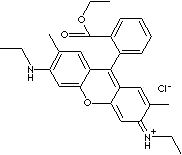PRODUCT IDENTIFICATION

c1(c2c([o+]c3c1cc(C)c(c3)NCC)cc(NCC)c(c2)C)c1c(C(OCC)=O) cccc1.[ClH-]
CLASSIFICATION
Xanthene, Fluorescent dye, Indicator, Luminescent agent
EXTRA NOTES
Overall Carcinogenic Evaluation: Group 3
PHYSICAL AND CHEMICAL PROPERTIES
Butanol (40), Ethanol (80), Methanol (400) Propanol (15), MEG (50), DEG ( 100), TEG (100), Isopropanol (15), Ethoxyethanol (25), Methoxyethanol (50), Dipropylene Glycol (30), PEG (20)
Water
(4-5), Soda (4-5), Acetic acid (4), Hcl (4),
Paraffin (5)
EXTERNAL LINKS & GENERAL DESCRIPTION
Wikipedia Linking - Rhodamine 6G
Google Scholar Search - Rhodamine 6G
Drug Information Portal (U.S. National Library of Medicine) - Rhodamine 6G
PubChem Compound Summary - Rhodamine 6G
KEGG (Kyoto Encyclopedia of Genes and Genomes) - Rhodamine 6G
http://www.ebi.ac.uk/ - Rhodamine 6G
http://www.ncbi.nlm.nih.gov/ - Rhodamine 6G
http://toxnet.nlm.nih.gov/
Hazardous Substances Data Bank - Rhodamine
6G
Local:
Basic dyes are
salts of the colored organic bases containing amino and imino groups and also
combined with a colorless acid, such as hydrochloric or sulfuric. They are
brilliant and most fluorescent among all synthetic dyes but have poor light and
wash fastness. Cotton dyes having higher fastness properties replace in dyeing
cotton for them. Basic dyes are cationic which has positive electrical charge
and are used for anionic fabrics which are negative-charge-bearing, such as
wool, silk, nylon, and acrylics where bright dying is the prime
consideration.
APPEARANCE
100 ± 3%
1.0% max
HAZARD OVERVIEW
Harmful if swallowed
GHS
PICTOGRAMS

HAZARD STATEMENTS
H302
P STATEMENTS
![]()
RISK PHRASES
22
SAFETY PHRASES
26